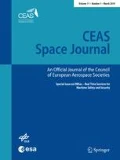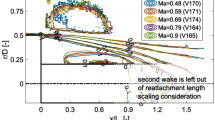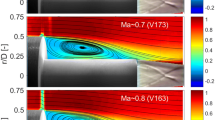Abstract
The turbulent wake of a generic space launcher wind tunnel model with an underexpanded nozzle jet is investigated experimentally and numerically to gain insight into the variation of intricate wake flow phenomena of space vehicles at higher stages of the flight trajectory with increasing Mach number. The experiments are carried out at \(M_\infty =3\) and \(M_\infty =6\) in the Ludwieg tube test facility at the Institute of Fluid Mechanics at the Technische Universität Braunschweig, while the corresponding time-resolved computations are performed by the Institute of Aerodynamics at RWTH Aachen University using a zonal RANS–LES approach. A strong alteration of the wake topology with increasing Mach number due to the changing pressure ratio at the nozzle exit is found. At \(M_\infty =3\) the moderate underexpansion rate of \(p_\mathrm{e}/p_\infty \approx 5\) leads to a formation of a recirculation region with an elongated triangular cross-section reaching to the nozzle exit. At \(M_\infty =6\) a substantially stronger afterexpansion of the jet plume (\(p_\mathrm{e}/p_\infty \approx 100\)) causes the formation of a cavity region with a quadrangular cross-section. The stronger deflection towards the nozzle at \(M_\infty =3\) results in lower mean and rms wall pressure ratios than at \(M_\infty =6\). However, due to the higher freestream pressure value at the lower Mach number the relation of absolute values is reciprocal, making the lower supersonic regime more critical with respect to dynamic structural loads. This observation is confirmed by an overall good agreement between numerical and experimental data at characteristic positions on the base and nozzle wall. Furthermore, it was shown that undesired effects of the strut support in the wake are present along the whole circumference. For \(M_\infty =3\) the strut influence is found to be particularly intense. The spectral analysis of wall pressure fluctuations reveals fundamental differences in the dynamic behavior of the two investigated wake flow regimes. At \(M_\infty =3\), a dominant frequency range around \(Sr_\mathrm{D}\approx 0.2\) associated with the inner dynamics of the recirculation bubble is found at the base, while on the nozzle a broad-band low-frequency content of substantially higher amplitudes is detected, which is a footprint of the graduate realignment of the turbulent shear layer along the nozzle wall. The spectra at \(M_\infty =6\) are characterized by several high-frequency sharp peaks at \(Sr_\mathrm{D}\geqslant 0.8\). A strong correlation between the supported wind tunnel configuration and the axisymmetric free-flight case is found for the peaks at \(Sr_\mathrm{D}\approx 0.85\) known to be caused by the radial flapping motion of the shear layer along the cavity.














Similar content being viewed by others
Abbreviations
- D :
-
Main body diameter
- M :
-
Mach number
- Re :
-
Reynolds number
- Sr :
-
Strouhal number
- x :
-
Streamwise distance (\(x=0\) in the base plane)
- \(\varphi\) :
-
Azimuthal position in deg (\(\varphi =0^\circ\) at the strut position)
- \(\delta\) :
-
Boundary layer thickness
- \(\Delta\) :
-
Grid resolution
- \(\infty\) :
-
Freestream conditions
- 0:
-
Total value
- e :
-
Value at the nozzle exit
- mean:
-
Time-averaged value
- rms:
-
Root-mean-square value
- \('\) :
-
Fluctuating part
- \(^+\) :
-
Wall unit
References
Hammond, W.: Design Methodologies for Space Transportation Systems. AIAA education series (2001). doi:10.2514/4.861734
Deprés, D., Reijasse, P., Dussauge, J.-P.: Analysis of unsteadiness in afterbody transonic flows. AIAA J. 42(12), 2541–2550 (2004)
Meliga, P., Reijasse, P.: Unsteady transonic flow behind an axisymmetric afterbody equipped with two boosters. AIAA Paper, p. 4564 (2007)
Deck, S., Thorigny, P.: Unsteadiness of an axisymmetric separating-reattaching flow: numerical investigation. Phys. Fluids 19, 065103 (2007)
Hannemann, K., Lüdeke, H., Pallegoix, J.-F., Ollivier, A., Lambare, H., Maseland, H., Geurts, E.G.M., Frey, M., Deck, S., Schrijer, F.F.J., Scarano, F., Schwane, R.: Launch vehicle base buffeting- recent experimental and numerical investigations. In: Proceedings 7th European Symposium on Aerothermodynamics for Space Vehicles, Brugge, Belgium, 9–12 May, vol. 692, p. 102 (2011)
Schrijer, F.F.J., Sciacchitano, A., Scarano, F., Hanneman, K., Pallegoix, J.F., Maseland, J.E.J., Schwane, R.: Experimental investigation of base flow buffeting on the Ariane 5 launcher using high speed PIV. In: Proceedings 7th European Symposium on Aerothermodynamics for Space Vehicles, Brugge, Belgium, 9–12 May, vol. 692, p. 103 (2011)
Schrijer, F.F.J., Sciacchitano, A., Scarano, F.: Spatio-temporal and modal analysis of unsteady fluctuations in a high-subsonic base flow. Phys. Fluids 26, 086101 (2014)
Marié, S., Druault, Ph, Lambaré, H., Schrijer, F.: Experimental analysis of the pressure-velocity correlations of external unsteady flow over rocket launchers. Aerosp. Sci. Technol. 30(1), 83–93 (2013)
Eaton, J.K., Johnston, J.P.: A review of research on subsonic turbulent flow reattachment. AIAA J. 19(9), 1093–1099 (1981)
Le, H., Moin, P., Kim, J.: Direct numerical simulation of turbulent flow over a backward-facing step. J. Fluid Mech. 330, 349–374 (1997)
Brewer, E.B., Craven, C.E.: Experimental investigation of base flow field at high altitude for a four-engine clustered nozzle configuration. NASA Technical Report TN D-5164 (1969)
Janssen, J.R., Dutton, J.C.: Time-series analysis of supersonic base-pressure fluctuations. AIAA J. 42, 605–613 (2004)
Bannink, W.J., Houtman, E.M., Bakker, P.G.: Base flow/underexpanded exhaust plume interaction in a supersonic external flow. AIAA Paper, pp. 98–1598 (1998)
Scarano, F., van Oudheusden, B.W., Bannink, W.J., Bsibsi, M.: Experimental investigation of supersonic base flow plume interaction by means of particle image velocimetry. In: Proceedings of the 5th European Symposium on Aerothermodynamics for Space Vehicles (ESA SP-563). Published by ESA Publications Division, pp. 601–607 (2005)
Saile, D., Gülhan, A.: Plume-induced effects on the near-wake region of a generic space launcher geometry. In: 32nd AIAA Applied Aerodynamics Conference, AIAA Aviation and Aeronautics Forum and Exposition, number AIAA 2014–3137 (2014)
Stephan, S., Wu, J., Radespiel, R.: Propulsive jet influence on generic launcher base flow. CEAS Space J 7(4), 453–473 (2015)
Benay, R., Servel, P.: Two-equation k-\(\sigma\) turbulence model: application to a supersonic base flow. AIAA J. 39, 407–416 (2001)
Papp, J.L., Ghia, K.N.: Application of the RNG turbulence model to the simulation of axisymmetric supersonic separated base flows. AIAA Paper , pp. 2001–2027 (2001)
Forsythe, J.R., Hoffmann, K.A., Cummings, R.M., Squires, K.D.: Detached-eddy simulation with compressibility corrections applied to a supersonic axisymmetric base flow. J. Fluid Eng. 124, 911–923 (2002)
Kawai, S., Fujii, K.: Computational study of a supersonic base flow using LES/RANS hybrid methodology. AIAA Paper, pp. 2004–2068 (2004)
Fureby, C., Kupiainen, K.: Large-eddy simulation of supersonic axisymmetric baseflow. In: Turbulent Shear Flow Phenomena, TSFP3, Sendai, Japan, vol. 3, pp. 1157–1162 (2003)
Sandberg, R.D., Fasel, H.F.: High-accuracy DNS of supersonic base flows and control of the near wake. In: Proceedings of the Users Group Conference, pp. 96–104. IEEE Computer Society (2004)
Sandberg, R.D., Fasel, H.F.: Numerical investigation of transitional supersonic axisymmetric wakes. J. Fluid Mech. 563, 1–41 (2006)
Strelets, M.: Detached eddy simulation of massively separated flows. AIAA Paper, pp. 2001–0879 (2001)
Lüdeke, J.D.M.H., Hannemann, K.: Launch vehicle base flow analysis using improved delayed detached-eddy simulation. AIAA J. 53(9), 2454–2471 (2015)
Statnikov, V., Meiß, J.-H., Meinke, M., Schröder, W.: Investigation of the turbulent wake flow of generic launcher configurations via a zonal RANS/LES method. CEAS Space J. 5(1–2), 75–86 (2013)
Statnikov, V., Sayadi, T., Meinke, M., Schmid, P., Schröder, W.: Analysis of pressure perturbation sources on a generic space launcher after-body in supersonic flow using zonal RANS/LES and dynamic mode decomposition. Phys. Fluids 27(016103), 1–22 (2015)
Sippel, M., Herbertz, A.: System requirements on investigation of base flow/plume interaction, vol. 98 of NNFM: RESPACE-Key Technologies for Reusable Space Systems. Springer (2003–2007)
Estorf, M., Wolf, T., Radespiel, R.: Experimental and numerical investigations on the operation of the hypersonic ludwieg tube braunschweig. In: Proceedings of the 5th European Symposium on Aerothermodynamics for Space Vehicles (ESA SP-563). Published by ESA Publications Division (2005)
Wu, J., Radespiel, R.: Tandem nozzle supersonic wind tunnel design. Int. J. Eng. Syst. Model. Simul. Proc. 5(1), 8–18 (2013). doi:10.1504/IJESMS.2013.052369
Wu, J., Zamre, P., Radespiel, R.: Flow quality experiment in a tandem nozzle wind tunnel at Mach 3. Exp. Fluids 56(20), 1–18 (2015). doi:10.1007/s00348-014-1887-1
Liou, M.-S., Steffen, C.J.: A new flux splitting scheme. J. Comput. Phys. 107, 23–39 (1993)
Boris, J., Grinstein, F., Oran, E., Kolbe, R.: New insights into large eddy simulation. Fluid Dyn. Res. 10, 199–228 (1992)
Meinke, M., Schröder, W., Krause, E., Rister, Th: A comparison of second- and sixth-order methods for large-eddy simulations. Comput. Fluids 31, 695–718 (2002)
Alkishriwi, N., Meinke, M., Schröder, W.: A large-eddy simulation method for low Mach number flows using preconditioning and multigrid. Comput. Fluids 35(10), 1126–1136 (2006)
El-Askary, W., Schröder, W., Meinke, M.: LES of compressible wall-bounded flows. AIAA Paper, pp. 2003–3554 (2003)
Spalart, P.R., Allmaras, S.R.: A one-equation turbulence model for aerodynamic flows. AIAA Paper, pp. 92–0439 (1992)
Allmaras, S.R., Johnson, F.T., Spalart, P.R.: Modifications and clarifications for the implementation of the spalart-allmaras turbulence model. In: 7th International Conference on Computational Fluid Dynamics (ICCFD7), ICCFD7-1902 (2012)
Roidl, B., Meinke, M., Schröder, W.: Reformulated synthetic turbulence generation method for a zonal RANS-LES method and its application to zero-pressure gradient boundary layers. Int. J. Heat Fluid Flow 44, 28–40 (2013)
Roidl, B., Meinke, M., Schröder, W.: Boundary layers affected by different pressure gradients investigated computationally by a zonal RANS-LES method. Int. J. Heat Fluid Flow 45, 1–13 (2014)
Jarrin, N., Benhamadouche, N., Laurence, S., Prosser, D.: A synthetic-eddy-method for generating inflow conditions for large-eddy simulations. Int. J. Heat Fluid Flow 27, 585–593 (2006)
Pamiès, M., Weiss, P.-É., Garnier, E., Deck, S., Sagaut, P.: Generation of synthetic turbulent inflow data for large eddy simulation of spatially evolving wall-bounded flows. Phys. Fluids 21, 045103 (2009)
Choi, H., Moin, P.: Grid-point requirements for large eddy simulation: Chapman’s estimates revisited. Center for Turbulence Research Annual Research Briefs (2011)
Priebe, S., Wu, M., Martin, P.: Direct numerical simulation of a reflected-shock-wave/turbulent-boundary-layer interaction read more. AIAA J. 47(5), 1173–1185 (2009). doi:10.2514/1.38821
Brown, G.L., Roshko, A.: On density effects and large structure in turbulent mixing layers. J. Fluid Mech. 64(6), 775–816 (1974)
Papamoschou, Dimitri, Roshko, Anatol: The compressible turbulent shear layer: an experimental study the compressible turbulent shear layer: an experimental study the compressible turbulent shear layer: an experimental study. J. Fluid Mech. 197, 453–477 (1988)
Saile, D., Gülhan, A., Henckels, A.: Investigations on the near-wake region of a generic space launcher geometry. AIAA, pp. 2011–2352 (2011)
Statnikov, V., Saile, D., Meiß, J.-H., Henckels, A., Meinke, M., Gülhan, A., Schröder, W.: Experimental and numerical investigation of the turbulent wake flow of a generic space launcher configuration. Prog. Flight Phys. 7, 329–350 (2015)
Acknowledgments
Financial support from the German Research Foundation (Deutsche Forschungsgemeinschaft DFG) in the framework of the Transregional Collaborative Research Center (SFB/TRR40) is gratefully acknowledged by the authors. Computational resources have been provided by the Stuttgart High-Performance Computing Center (HLRS).
Author information
Authors and Affiliations
Corresponding author
Rights and permissions
About this article
Cite this article
Statnikov, V., Stephan, S., Pausch, K. et al. Experimental and numerical investigations of the turbulent wake flow of a generic space launcher at \(M_\infty =3\) and \(M_\infty =6\) . CEAS Space J 8, 101–116 (2016). https://doi.org/10.1007/s12567-016-0112-x
Received:
Revised:
Accepted:
Published:
Issue Date:
DOI: https://doi.org/10.1007/s12567-016-0112-x




